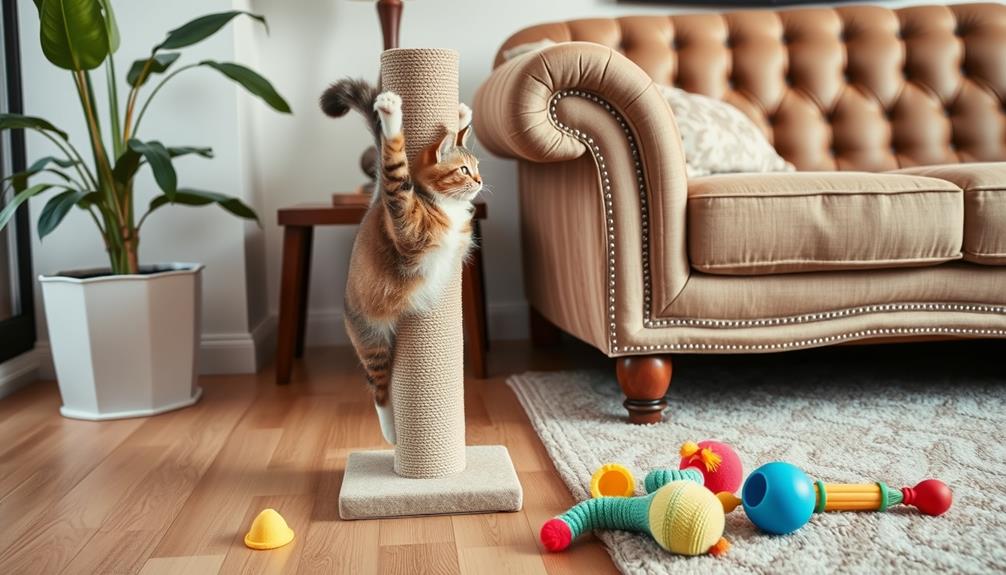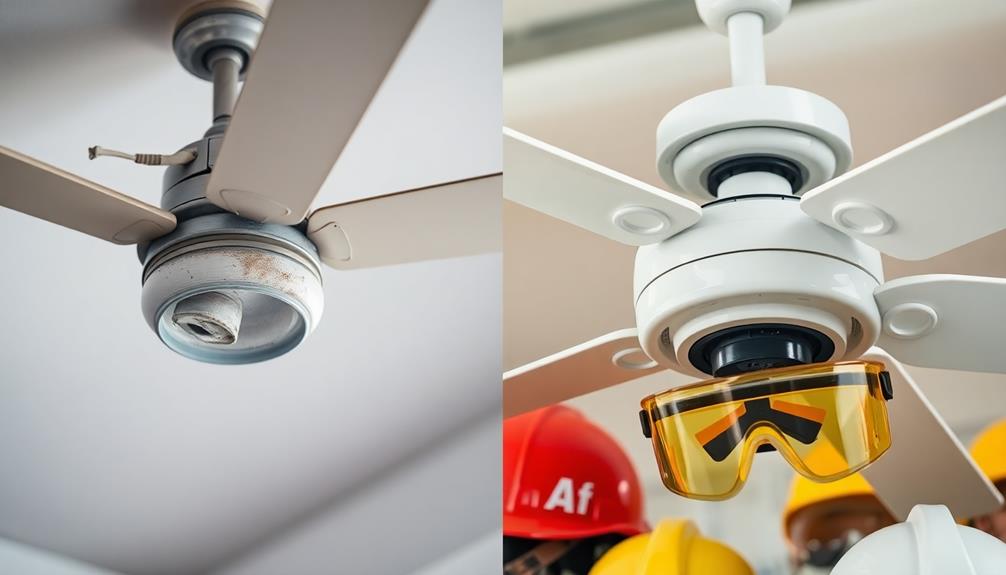To prevent your cat from damaging furniture by scratching, it’s important to recognize that it’s a natural behavior for them. Offer durable scratching posts made from sisal or wood and place them in high-traffic areas. Encourage your cat to utilize these posts by rewarding them with treats and praise. Unwanted scratching can be discouraged by using sticky tape or aluminum foil on your furniture. Regular interactive playtime can also aid in reducing anxiety-induced scratching. Remember to keep the scratching posts engaging by relocating them periodically. If you need additional advice and techniques to safeguard your home, there are numerous effective methods available.
Key Takeaways
- Provide sturdy scratching posts made from natural materials like sisal or cardboard to redirect scratching behavior effectively.
- Position scratching posts in high-traffic areas and rotate their locations to maintain your cat's interest.
- Use positive reinforcement, such as treats and praise, to encourage your cat to use designated scratching areas.
- Employ protective furniture covers like slipcovers or vinyl shields to minimize damage while maintaining appearance.
- Create an enriching environment with cat trees and regular play sessions to reduce anxiety-related scratching.
Understanding Cat Scratching Behavior
Understanding cat scratching behavior is fundamental for any cat owner. Scratching isn't just a habit; it's an instinctual action that serves multiple purposes. Your cat scratches to mark territory using both visual cues and chemical signals, starting as early as 8 weeks.
This behavior also helps with nail sharpening and muscle stretching, which are essential for their physical health and emotional well-being. Additionally, much like individuals with BPD who exhibit emotional responses through relationships, cats may scratch as a way to express their feelings or alleviate stress.
You might notice that many cats prefer vertical surfaces, often targeting your furniture like couch arms or unvarnished wood. This preference highlights the significance of providing suitable scratching posts that cater to their natural instincts. Remember, individual cat preferences matter; what works for one cat may not appeal to another.
To effectively manage scratching behavior, you need to understand these motivations. Instead of viewing scratching as a nuisance, consider it a crucial part of your cat's life.
Providing Effective Alternatives
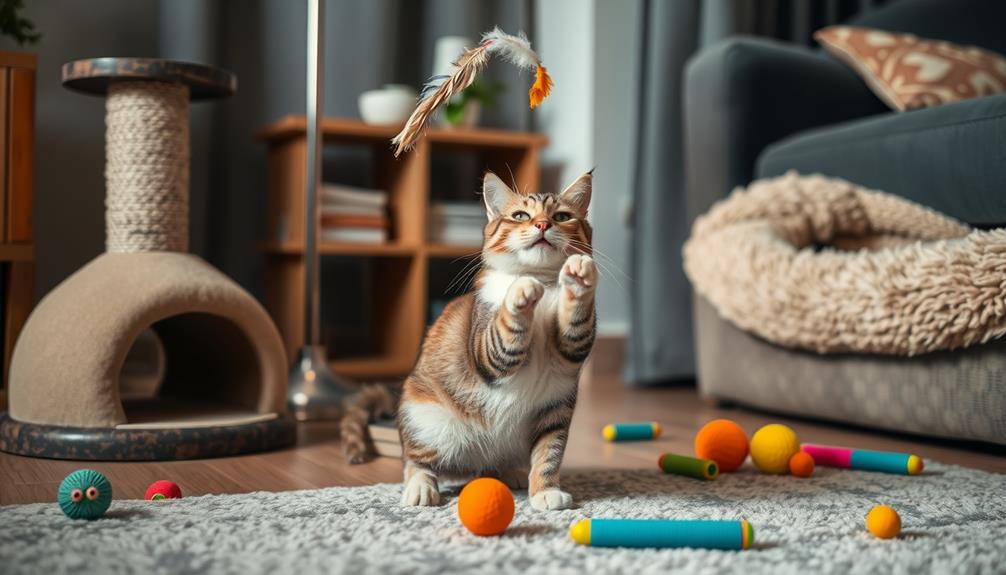
To keep your cat from scratching your furniture, it's crucial to provide the right alternatives.
Consider using natural materials that are safe and engaging for your pet, such as sisal or cardboard.
Focus on tall, sturdy scratching posts made from durable materials, and place them strategically near the spots your cat likes to target.
By offering these effective options, you'll encourage your furry friend to scratch where it's appropriate.
Additionally, rewarding your cat with healthy treats can reinforce positive behavior and keep them engaged in their new scratching habits.
Ideal Scratching Post Features
Choosing the right scratching post can make all the difference in keeping your furniture safe. The ideal scratching post features should cater to your cat's natural instincts and preferences.
For instance, understanding your cat's behavior can help you select the most appealing option, as proper enrichment is vital for their well-being (understanding puffed-up behavior).
Here are some key elements to look for:
- Height: Make certain it's tall enough for your cat to stretch fully while scratching. This is essential for their physical health.
- Material: Opt for materials like sisal rope, fabric, or wood. Cats are more likely to choose these over your furniture when they feel the texture they like.
- Stability: A broad, stable base is critical. It guarantees the post won't topple over during use, providing a safe and satisfying scratching experience.
Strategic Placement Tips
Placing scratching posts strategically around your home can greatly influence your cat's scratching habits. Position these scratching posts in high-traffic areas and near your cat's favorite furniture to increase their likelihood of use. Cats are more inclined to engage with scratching posts that are easily accessible.
Make certain the posts are tall and sturdy, allowing your cat to stretch fully while scratching, mimicking their natural behavior.
In multi-cat households, experiment with multiple scratching posts in different locations to reduce competition and encourage individual use. Alongside the scratching posts, introduce texture alternatives like textured floor mats or horizontal scratchers near spots where your cat frequently scratches furniture. These options can draw your cat's attention away from your beloved couch.
To keep your cat engaged, regularly rotate the locations of scratching posts and alternatives. This strategic placement not only enhances novelty, but it also guarantees that your cat remains interested in using them.
Training Techniques for Cats
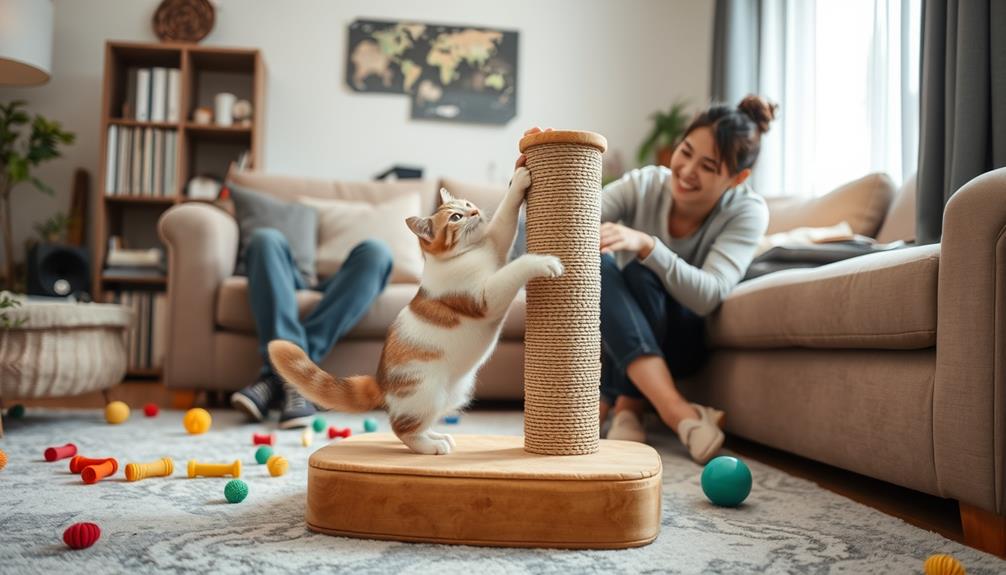
While cats naturally scratch to maintain their claws and mark territory, training them to prefer designated scratching surfaces can protect your furniture.
Start by providing sturdy scratching posts made of materials like sisal or cardboard. This way, your cat will have appealing alternatives.
To effectively train your cat, use positive reinforcement techniques. Reward them with treats and praise when they use the scratching post instead of your furniture.
Here are some steps to help you:
- Redirect your cat immediately when you catch them scratching furniture; guide them to the scratching post.
- Use sticky tape or aluminum foil on furniture surfaces they frequently scratch to create an unpleasant texture, discouraging them from returning.
- Regular nail trimming will reduce damage, making it less likely for your cat to leave significant marks.
Addressing Anxiety and Enrichment
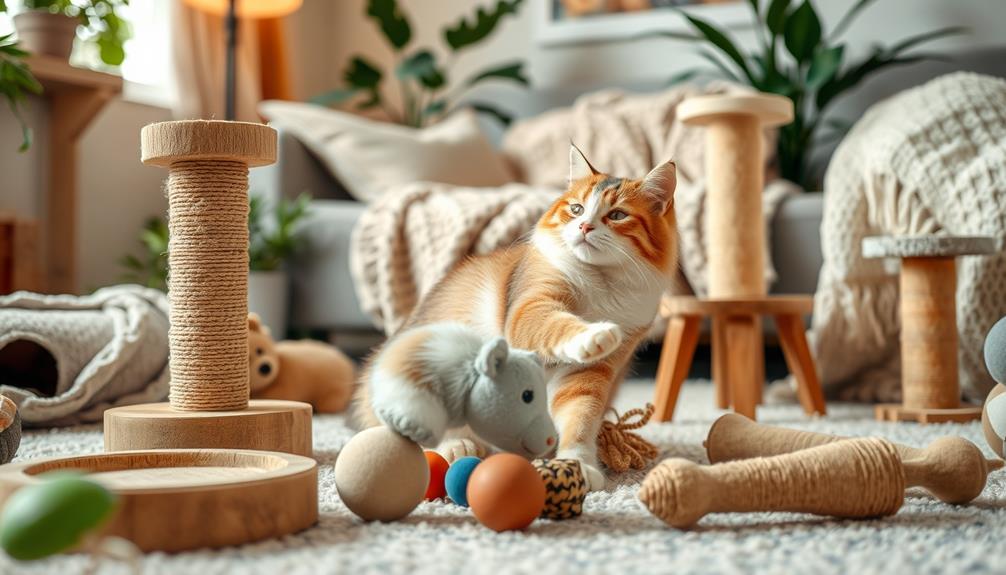
Many cats scratch furniture out of anxiety, so addressing this issue involves enriching their environment. Providing your cat with stimulating activities can greatly reduce anxiety and redirect their scratching behavior.
| Enrichment Activity | Benefits |
|---|---|
| Cat Trees | Offers climbing and scratching options, promoting mental stimulation. |
| Regular Play Sessions | Engages your cat, reducing stress and anxiety levels. |
| Outdoor Experiences | Secure leash walks or a catio provides new sights and smells. |
Incorporate cat trees and interactive toys into your home to encourage healthy scratching habits. It is crucial to schedule regular play sessions to keep your cat mentally engaged. If you notice excessive scratching, consider consulting a Certified Applied Animal Behaviorist, who can provide tailored strategies to address anxiety.
Additionally, calming supplements or veterinary-prescribed medications may help alleviate underlying anxiety. Implementing these enrichment strategies can create a happier, healthier environment for your cat, ultimately reducing their need to scratch furniture. Stay proactive in providing mental stimulation, and you'll likely see a positive change in their behavior.
Avoiding Harmful Practices
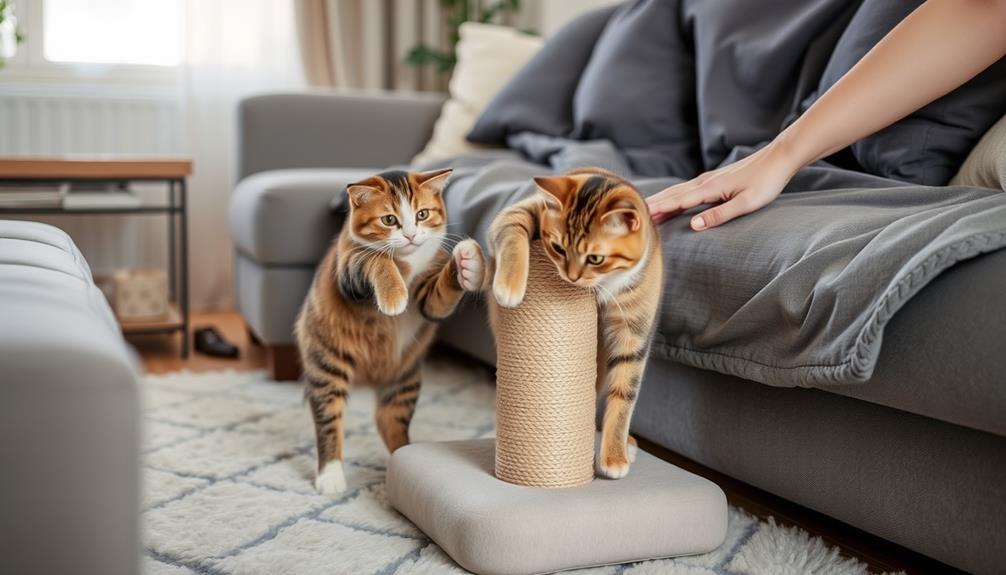
When you want to curb your cat's scratching behavior, it's crucial to avoid harmful practices that can cause more harm than good. Declawing, for instance, isn't only a painful procedure but also fails to address the root cause of scratching. Instead of solving the issue, it can lead to behavioral problems down the line.
Here are some practices to steer clear of:
- Punitive measures: Yelling or using water sprays can create fear and anxiety, worsening your cat's behavior.
- Declawing: This invasive procedure is inhumane and can lead to aggression and frustration.
- Ignoring scratching behavior: Failing to redirect your cat can encourage continued scratching.
Instead, focus on positive reinforcement techniques. Redirect your cat's attention to appropriate scratching surfaces, and consider humane alternatives like regular nail trims or claw caps.
Recommended Supplies for Prevention
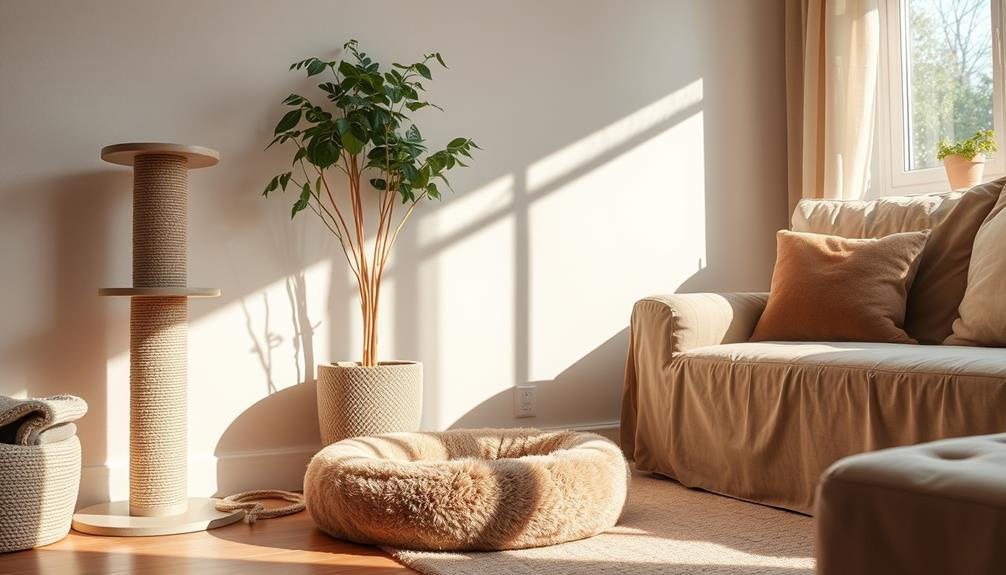
To effectively prevent your cat from scratching furniture, consider investing in effective scratching posts and alternative scratch surfaces.
These supplies not only fulfill your cat's natural instincts but also protect your home.
Additionally, using protective furniture covers can help keep your furniture safe while you encourage better scratching habits. It’s also important to regularly trim your cat’s nails to minimize the damage they can cause. If your cat has already done significant damage to your furniture, consider disposing of old furniture and replacing it with more scratch-friendly alternatives to prevent further destruction.
Effective Scratching Posts
Choosing the right scratching posts is fundamental for your cat's well-being and your furniture's safety. Tall and sturdy scratching posts encourage your cat to stretch fully while scratching, which is essential for their physical health.
To stop your cat from damaging your furniture, guarantee the posts are made from preferred materials like sisal, fabric, or wood.
Here are some features to look for in effective scratching posts:
- Height and Stability: Choose tall, sturdy posts that allow your cat to stretch comfortably.
- Interactive Features: Incorporate cat toys or surfaces that mimic natural scratching materials to pique their interest.
- Strategic Placement: Position scratching posts in high-traffic areas and near your cat's favorite furniture to make them more appealing.
Regularly maintaining and replacing scratching posts is also significant for preventing damage and keeping your cat engaged in healthy scratching behavior.
Alternative Scratch Surfaces
A variety of alternative scratch surfaces can greatly reduce your cat's urge to scratch furniture. Incorporating stable and tall scratching posts allows your cat to stretch fully, fulfilling their natural instincts while protecting your furniture.
Look for scratching posts made from sisal or other durable materials that cater to your cat's preferences, promoting healthy scratching habits.
In addition to scratching posts, consider providing textured floor mats or scratch pads made from cardboard. These options can be cost-effective and appealing to your cat.
Interactive scratching posts with engaging designs can keep your feline friend occupied, encouraging them to use these alternatives instead of your furniture.
You might also want to use organic catnip pouches on these surfaces to draw your cat's attention, further enticing them to scratch designated areas.
By offering a variety of alternative scratching surfaces, you can effectively redirect your cat's scratching behavior, ensuring your furniture stays safe.
Protective Furniture Covers
Protective furniture covers are a smart investment for any cat owner looking to preserve their furniture while maintaining an appealing home.
These covers can effectively shield delicate surfaces, like leather furniture, from unsightly scratch marks and claw marks. By draping throw blankets or faux sheepskin rugs over your furniture, you create a barrier that minimizes damage and enhances your decor.
Here are a few options to evaluate:
- Throw blankets: Easy to wash and stylish, they protect surfaces while adding comfort.
- Slipcovers: Specifically designed for your furniture type, they provide a tailored fit and are machine washable for convenience.
- Furniture shields: Clear vinyl or plastic covers adhere to your furniture, offering an invisible barrier against scratches without affecting appearance.
Regularly rotating or replacing your protective furniture covers will help maintain their effectiveness and keep your home looking fresh.
Additional Resources for Support
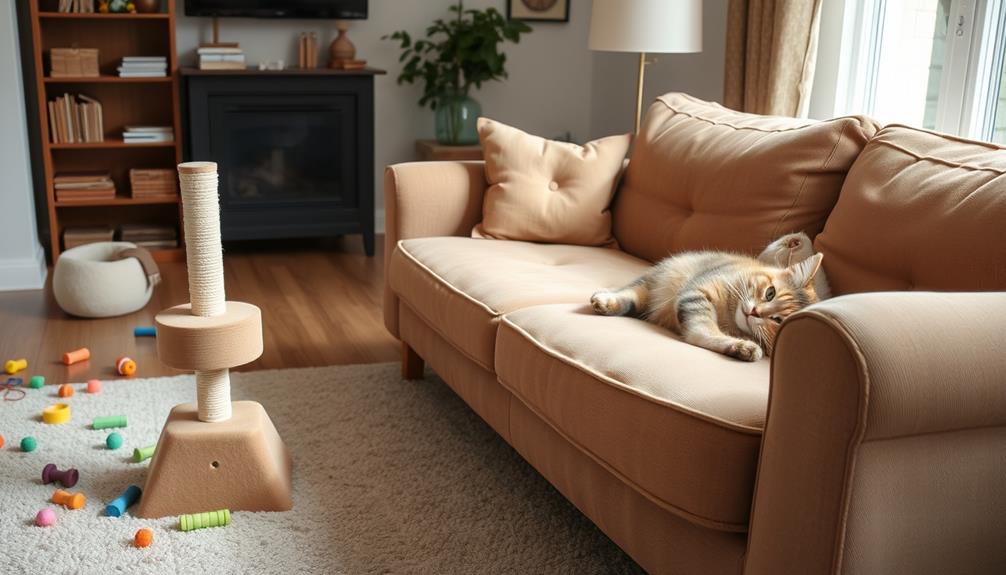
For anyone struggling with a cat's scratching behavior, various resources are available to provide the support you need. Free video consultations with veterinary professionals can offer valuable advice on managing your cat's scratching without requiring prescriptions or diagnoses.
Exploring articles on cat care can deepen your understanding of your pet's needs, addressing not only scratching but also litter box issues and parasite prevention. Subscribing to newsletters from veterinarians guarantees you stay updated with ongoing tips and strategies to maintain your cat's health and protect your furniture.
Additionally, engaging with community resources can connect you to local pet behaviorists who can provide personalized support tailored to your cat's specific scratching issues. Consider consulting with a Certified Applied Animal Behaviorist for effective, individualized strategies to tackle scratching behavior in your home.
These experts can help you craft a plan that suits your cat's unique personality and environment. By utilizing these resources, you can foster a more harmonious living situation, reducing the damage to your furniture while guaranteeing your cat remains happy and healthy.
Frequently Asked Questions
How Do I Stop My Cat From Scratching My Couch?
To stop your cat from scratching your couch, place sturdy scratching posts nearby, use double-sided tape on the couch, and apply citrus-scented spray. Reinforce positive behavior with catnip and create a calming environment with pheromones.
What Deters Cats From Scratching Furniture?
To deter cats from scratching furniture, use sticky tape on surfaces, apply citrus sprays, or place scratching posts nearby. Covering furniture with blankets can also help protect it while discouraging unwanted scratching behaviors. Another tactic for preventing cat scratches is to trim the cat’s nails regularly or use soft nail caps. Additionally, giving the cat plenty of toys and attention can help redirect their energy away from destructive scratching. It’s important to remember that cats scratch instinctively, so providing appropriate outlets for this behavior is crucial in preventing damage to furniture.
How Do You Stop Cats From Scratching Furniture DIY?
"An ounce of prevention is worth a pound of cure." To stop your cat from scratching, use double-sided tape, provide scratching posts, and regularly trim their claws to encourage appropriate behavior and protect your furniture.
What Scent Will Keep Cats From Scratching?
To keep cats from scratching, try using citrus scents like lemon or orange, or vinegar and rosemary mixtures. They're unpleasant for cats and can effectively deter unwanted scratching behavior in your home.
Conclusion
By understanding your cat's scratching habits and offering enticing alternatives, you can create a harmonious home where both your furniture and feline thrive. Think of it as planting a garden of solutions—each scratching post and toy is a vibrant flower, drawing your cat away from your precious upholstery. With patience and the right techniques, you'll weave a tapestry of joy that keeps your furniture safe and your cat content, transforming your living space into a sanctuary for both.
